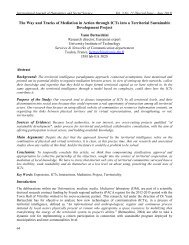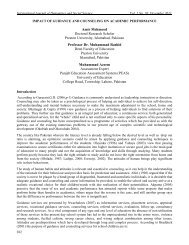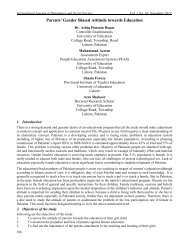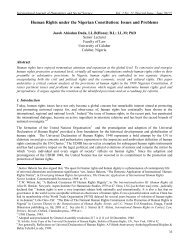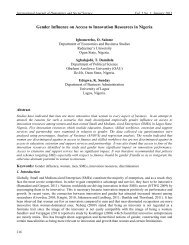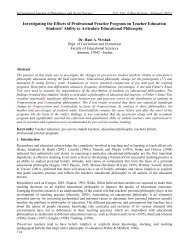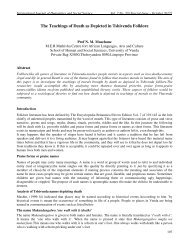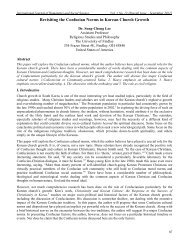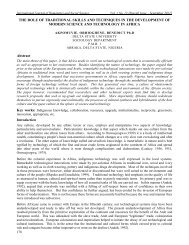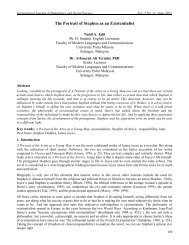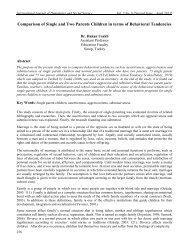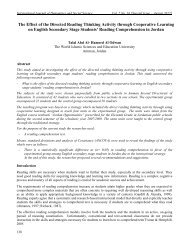Scaffolding to Improve Reading Comprehension and to Write a ...
Scaffolding to Improve Reading Comprehension and to Write a ...
Scaffolding to Improve Reading Comprehension and to Write a ...
You also want an ePaper? Increase the reach of your titles
YUMPU automatically turns print PDFs into web optimized ePapers that Google loves.
International Journal of Humanities <strong>and</strong> Social Science Vol. 1 No. 16; November 2011<br />
<strong>Scaffolding</strong> <strong>to</strong> <strong>Improve</strong> <strong>Reading</strong> <strong>Comprehension</strong> <strong>and</strong> <strong>to</strong> <strong>Write</strong> a Scholarly Research Paper<br />
Abstract<br />
Gladys E. Huggins<br />
Wins<strong>to</strong>n-Salem State University<br />
601 South Martin Luther King Junior Drive<br />
Wins<strong>to</strong>n-Salem, NC 27110<br />
USA<br />
Rita Edwards<br />
Wins<strong>to</strong>n-Salem State University<br />
601 South Martin Luther King Junior Drive<br />
Wins<strong>to</strong>n-Salem, NC 27110<br />
USA<br />
Two action research studies were done <strong>to</strong> assess the effectiveness of utilizing instructional scaffolding in reading<br />
<strong>and</strong> writing courses on the college level. The purpose was <strong>to</strong> determine if instructional scaffolding would make<br />
an impact on students’ reading <strong>and</strong> writing performance. Prior <strong>to</strong> implementation of the research studies, the<br />
teacher in a Freshman Composition II class used graphic organizers <strong>and</strong> other scaffolding strategies <strong>to</strong> support<br />
reading comprehension. As a result of positive feedback from students, action research was planned <strong>and</strong><br />
implemented in World Literature 1 <strong>to</strong> see if graphic organizers would improve students’ underst<strong>and</strong>ing of the<br />
Epic of Son-Jara, <strong>and</strong> in Freshman Composition 1 <strong>to</strong> support the process of writing a scholarly research paper.<br />
Results show that graphic organizers, as scaffolding <strong>to</strong>ols in the classroom, can help <strong>to</strong> improve reading<br />
comprehension, <strong>and</strong> students can benefit in several ways when teachers scaffold the process of writing a research<br />
paper.<br />
Keywords: reading comprehension, instructional scaffolding, research paper, graphic organizers, writing<br />
performance, action research studies, Freshman Composition, World Literature<br />
1.0 Introduction<br />
Academicians, scholars, working professionals <strong>and</strong> most others would agree that reading <strong>and</strong> writing are<br />
necessary <strong>and</strong> fundamental 21st-Century skills. For as long as the concept of teaching has existed, educa<strong>to</strong>rs at all<br />
levels <strong>and</strong> from all geographical backgrounds have faced diverse <strong>and</strong> critical challenges when addressing the vital<br />
issue of teaching students. Such challenges are still prevalent <strong>to</strong>day, especially concerning the fundamental<br />
subjects, “reading” <strong>and</strong> “writing”. A significant number of students lack the necessary skills <strong>to</strong> perform<br />
successfully when reading texts. Because they lack these necessary skills, they are unable <strong>to</strong> contribute<br />
meaningfully <strong>to</strong> class discussions. Overall, they fail <strong>to</strong> complete writing assignments successfully; they don‟t do<br />
well on exams, <strong>and</strong> finally, many experience academic failure. Ultimately, inadequate reading <strong>and</strong> writing skills<br />
adversely impact student dropout <strong>and</strong>/or retention rates. More attention must be given <strong>to</strong> the reading <strong>and</strong> writing<br />
performance of American students as they are instructed <strong>and</strong> men<strong>to</strong>red in this 21 st Century.<br />
Public attention was focused on the reading abilities (or disabilities) of Americans, including students, as revealed<br />
in a major report released by the National Endowment for the Arts (NEA). To Read or Not <strong>to</strong> Read shows that<br />
overall Americans are reading less. It describes how our culture <strong>and</strong> economy are negatively impacted by the<br />
nation‟s diminishing reading habits. Leddy (2008) writes that “the NEA report is especially depressing in<br />
detailing the severe drop in reading among teenagers <strong>and</strong> young adults….The NEA report notes that 38 percent of<br />
employers rate high school graduates as „deficient‟ in reading skills, while a shocking 72 percent of employers<br />
rate such graduates as „deficient‟ in writing skills”(p. 8). This new generation of students is spending more time<br />
reading on the Internet <strong>and</strong> less time reading printed materials such as books.<br />
In her edi<strong>to</strong>rial, “<strong>Reading</strong> as a 21st-Century Skill Can Not Be Taken Lightly,”<br />
Levi<strong>to</strong>v (2010) reminds us that students need reading <strong>and</strong> writing skills as well as the ability <strong>to</strong> communicate <strong>and</strong><br />
comprehend in order <strong>to</strong> use online or print resources. Even social networking requires the use of reading <strong>and</strong><br />
writing skills. The author notes, “with electronic access comes the need for new skills for navigating <strong>and</strong><br />
comprehending text <strong>and</strong> content in digital form.”<br />
30
© Centre for Promoting Ideas, USA www.ijhssnet.com<br />
In this new millennium, educa<strong>to</strong>rs face challenges as they commit themselves <strong>to</strong> help prepare students <strong>to</strong> enter a<br />
global, competitive society. There are times when educa<strong>to</strong>rs find themselves using instructional strategies they<br />
have never used before, or modifying strategies already used <strong>to</strong> accommodate a new group of students with<br />
unique qualities. Instructional scaffolding, an old concept with a new name, can be modified <strong>and</strong> used in diverse<br />
ways across disciplines. Two action research studies were done in the fall semester of 2009, in different college<br />
classrooms by different instruc<strong>to</strong>rs, <strong>to</strong> help determine if instructional scaffolding would make an impact on<br />
students‟ reading <strong>and</strong> writing performance. The use of graphic organizers as <strong>to</strong>ols <strong>to</strong> help teach reading in World<br />
Literature 1, <strong>and</strong> the process of scaffolding a research paper in Freshman Composition 1 were examples of<br />
modifying instructional strategies <strong>to</strong> guide student learning. An instructional scaffolding strategy was used briefly<br />
the prior (spring) semester as a type of pilot study or experiment. Students were guided in using graphic<br />
organizers <strong>to</strong> complete a reading assignment in Freshman Composition II, a composition class with a focus on<br />
literary works. The experiment was repeated in Freshman Composition II the fall semester of 2009. A summary of<br />
observations from the brief study will be given in this article, followed by detailed discussions of the two action<br />
research projects.<br />
2.0 Instructional <strong>Scaffolding</strong>: Using Graphic Organizers <strong>to</strong> Guide Students in Comprehending Texts<br />
Instructional scaffolds are similar <strong>to</strong> the scaffolding used in construction <strong>to</strong> support workers as they work on<br />
specific tasks. Put in place as temporary support structures, they assist students in accomplishing new concepts<br />
<strong>and</strong> tasks they could not usually achieve on their own (“Instructional <strong>Scaffolding</strong>,” 2002). Larkin writes, “Using<br />
scaffolded instruction optimizes student learning by providing a supportive environment while facilitating student<br />
independence. The concept of scaffolding (Bruner, 1975) is based on the work of Vygotsky, who proposed that<br />
with an adult's assistance, children could accomplish tasks that they ordinarily could not perform independently”<br />
(2002). Using instructional scaffolds <strong>to</strong> help develop reading comprehension in English classes provide the<br />
support, assistance, <strong>and</strong> the confidence students need <strong>to</strong> read <strong>and</strong> <strong>to</strong> comprehend effectively.<br />
2.1 <strong>Reading</strong> <strong>and</strong> Comprehending Poetry<br />
Freshman Composition II is a writing course with an emphasis on reading, analyzing, <strong>and</strong> writing about literary<br />
works. In this course a pre-course writing assessment is administered each semester, beginning on the second day<br />
the class meets. Students are required <strong>to</strong> read two brief literary works <strong>and</strong> <strong>to</strong> write a literary critical analysis or a<br />
comparison/contrast essay of approximately 450 words, using instructions provided <strong>to</strong> them. When reading these<br />
essays, teachers observe students‟ strengths <strong>and</strong> weaknesses in the areas of reading comprehension/critical<br />
reading, analyzing, <strong>and</strong> writing. “Salvation” by Langs<strong>to</strong>n Hughes <strong>and</strong> “In Church” by Thomas Hardy are<br />
sometimes the two assigned literary works for the pre-course writing assessment. Of the two, teachers have<br />
observed that many students don‟t fully comprehend the very brief poem, “In Church.” In the spring <strong>and</strong> the fall<br />
of 2009, in Freshman Composition classes, instructional scaffolding was used <strong>to</strong> determine if it would have an<br />
effect on student comprehension of the poem. Activities included giving students a graphic organizer so they<br />
could organize their thoughts, reading the poem aloud, engaging students in dialog as the students defined terms,<br />
asking probing questions, making a few interpretive remarks, <strong>and</strong> having students <strong>to</strong> re-read the poem <strong>and</strong> record<br />
facts <strong>and</strong> conclusions on the graphic organizer. These are examples of probing questions that were asked as the<br />
teacher guided the discussion:<br />
1. To whom does Hardy refer in the first three lines: he ends, his voice, he bows <strong>and</strong> bends?<br />
2. What does, “his voice thrills up <strong>to</strong> the <strong>to</strong>pmost tile” mean? Consider the meaning of your two<br />
words: <strong>to</strong>pmost <strong>and</strong> tiles.<br />
3. What does, “each listener chokes” mean? Do they fall down <strong>and</strong> die?<br />
4. How does emotion “pervade the aisles”?<br />
Students were then asked <strong>to</strong> explain what happens in the next few lines of the poem.<br />
In summary, students‟ verbal responses <strong>and</strong> written feedback revealed that during the scaffolding activity,<br />
students gained a better underst<strong>and</strong>ing of the poem. The graphic organizer, a type of scaffold, encouraged students<br />
<strong>to</strong> think about information in new ways. As a result of positive feedback from students in Freshman Composition<br />
II, action research was planned <strong>and</strong> implemented in World Literature 1 <strong>to</strong> see if graphic organizers would improve<br />
students‟ underst<strong>and</strong>ing of the Epic of Son-Jara, a much longer literary work.<br />
2.2 Action Research Project #1- <strong>Reading</strong> The Epic of Son- Jara<br />
World Literature 1 is a core requirement that focuses on critical reading, critical writing <strong>and</strong> critical thinking.<br />
31
International Journal of Humanities <strong>and</strong> Social Science Vol. 1 No. 16; November 2011<br />
<strong>Reading</strong> literary works such as Son-Jara is a required assignment <strong>and</strong> possibly the most complicated reading<br />
assignment for students. For this action research project, the teacher supported the process of reading by<br />
scaffolding the process. Action research methods consisted of carefully explaining the assignments, providing<br />
graphic organizers during the time students were reading the Epic of Son-Jara, administering a unit test at the<br />
end of the unit <strong>and</strong> administering the final exam at the end of the semester. The research question was, “Will the<br />
use of instructional scaffolding in World Literature 1 improve students‟ reading comprehension skills?” All<br />
participants in the action research were students enrolled in World Literature 1. The experimental group met in a<br />
morning class while the control groups met either in the morning or afternoon.<br />
2.3 Procedures<br />
All students enrolled in four World Literature 1 classes were taught by the same instruc<strong>to</strong>r, read the same literary<br />
works, received the same number of out-of-class <strong>and</strong> in-class assignments (lectures, readings, study questions,<br />
journal writing, test development, essays, <strong>and</strong> group assignments) except for the utilization of graphic organizers<br />
by the experimental group, <strong>and</strong> they were evaluated by the same instrument.<br />
The experimental group utilized instructional scaffolds -selected graphic organizers- when reading Son-Jara.<br />
Before students were introduced <strong>to</strong> the literary work Son-Jara, each student was given a copy of a KWL graphic<br />
organizer <strong>to</strong> determine who, if anyone, knew any facts about the Epic of Son-Jara. That particular graphic<br />
organizer had three categories: 1) K-What do you know about the epic 2) W-What do you want <strong>to</strong> know about the<br />
work, <strong>and</strong> 3) L-What did you learn about the reading. Based on students‟ responses for category 1, 100% of the<br />
students were unfamiliar with the epic. Responses for category 2 revealed that 100% of the students were<br />
interested in knowing the purpose of studying Son-Jara, the types of conflict found in the work <strong>and</strong> the moral of<br />
the epic. One hundred percent of students responded <strong>to</strong> category 3 by stating what information had been learned<br />
after reading Son-Jara. The students responded with two or more sentences.<br />
Here are some examples of responses <strong>to</strong> category 3.<br />
Son-Jara has many praise names throughout the epic<br />
I learned that Son-Jara is an African epic of the M<strong>and</strong>en people;<br />
Son-Jara was exiled <strong>and</strong> could not walk for nine years;<br />
Sumamuru was an evil <strong>and</strong> bad king;<br />
Son-Jara was the second born, but was announced as the first born.<br />
A second graphic organizer labeled “characterization” displayed six categories as follows: character‟s name,<br />
appearance, actions, thoughts, speech, <strong>and</strong> reaction from others. Students were asked <strong>to</strong> review episode one (a<br />
short episode) of Son-Jara <strong>and</strong> find any character‟s names listed. Once students were able <strong>to</strong> locate the first name,<br />
they were <strong>to</strong>ld <strong>to</strong> focus their attention on that name <strong>and</strong> then write that particular character‟s name under the<br />
column labeled character. Students were directed <strong>to</strong> provide any information relevant <strong>to</strong> those six categories.<br />
After they completed information for the initial character, they followed the same procedure for other characters<br />
in episode one <strong>and</strong> recorded that information under the proper heading. Guidance was provided <strong>to</strong> students for<br />
approximately 20 minutes allowing them ample time <strong>to</strong> grasp the process. Upon realizing students were able <strong>to</strong><br />
work independently, support was withdrawn.<br />
A third graphic organizer utilized by students was a s<strong>to</strong>ry map in which students completed information based on<br />
setting, characters, problems, events <strong>and</strong> solutions. Students were directed <strong>to</strong> write the title Son-Jara on the first<br />
line <strong>and</strong> information pertaining <strong>to</strong> the setting for a part of episode three. They were then given further instructions<br />
<strong>to</strong> continue providing information for the remaining categories, using class time <strong>to</strong> complete the task.<br />
A fourth graphic organizer required information related <strong>to</strong> cause <strong>and</strong> effect. Students were given the option <strong>to</strong><br />
select a part from the epic in which they were interested in discussing in more detail. They were required <strong>to</strong> state<br />
an event <strong>and</strong> show the cause created by that event. The majority of the class decided <strong>to</strong> display information<br />
pertaining <strong>to</strong> Son-Jara‟s birth announcement <strong>and</strong> the problems created due <strong>to</strong> the messenger delivering an<br />
incorrect message.<br />
When the class completed the study of Son-Jara, they were given a unit test based on the literary work. The test<br />
consisted of four fill-in the-blank questions, 15 matching questions pertaining <strong>to</strong> characters, three questions<br />
related <strong>to</strong> theme, three questions related <strong>to</strong> setting, 10 questions related <strong>to</strong> plot <strong>and</strong> four questions related <strong>to</strong><br />
connections with fairytales <strong>and</strong> <strong>to</strong>day‟s culture.<br />
32
© Centre for Promoting Ideas, USA www.ijhssnet.com<br />
2.4 Results <strong>and</strong> Observations<br />
The experimental group scored lower on the unit test compared <strong>to</strong> the controlled group of students that were not<br />
introduced <strong>to</strong> the scaffolding process. The average for the experimental group was 82.52 compared <strong>to</strong> the average<br />
87.30 for the control group. This probably can be attributed <strong>to</strong> the day <strong>and</strong> time the experimental group met. It<br />
was discovered that students from the experimental group shared test information with students who were<br />
enrolled in classes at a later time on the same day <strong>and</strong> classes held the following day. At the end of the semester,<br />
the teacher administered the final exam which included 24 multiple choice questions for the literary work Son-<br />
Jara. The mean score for the experimental group was 84.6 which is a slightly higher score compared <strong>to</strong> 82.6 for<br />
the controlled group.<br />
2.5 Discussion<br />
Several graphic organizers were used <strong>to</strong> determine if scaffolding actually assisted students with reading <strong>and</strong><br />
comprehending the literary work Son-Jara. Based on the final examination, students who were introduced <strong>to</strong><br />
graphic organizers scored slightly higher than students who did not use the scaffolding process; however, the unit<br />
test scores did not display that the scaffolding process made a difference. The experimental group scored lower<br />
than the control group on the unit test which can be attributed <strong>to</strong> the sharing of information by students in the<br />
experimental group with students whose classes were held later in the day <strong>and</strong> on another day.<br />
3.0 Action Research Project #2: Writing a Scholarly Research Paper<br />
Freshman Composition I, a core requirement, focuses on reading, writing <strong>and</strong> thinking skills. The action research<br />
project involved scaffolding the process of writing a research paper for first year college students. Since writing a<br />
research paper is an English course requirement, the major objective was <strong>to</strong> provide support for students as they<br />
completed this requirement. Students were supported through instructional scaffolding in the classroom so they<br />
could “complete the process of writing a scholarly research paper in a timely manner.” Forty-five, first semester<br />
college freshmen agreed <strong>to</strong> participate in the study. These students had successfully <strong>and</strong> voluntarily enrolled in<br />
Freshman Composition during the registration <strong>and</strong>/or add-drop period. The research project was presented <strong>to</strong> all<br />
students in class on a designated day, <strong>and</strong> students who wanted <strong>to</strong> participate signed an informed consent form.<br />
3.1 Research Focus<br />
The project was guided by the research question; “Will the use of instructional scaffolding in Freshman<br />
Composition 1 support the process of writing a research paper?” In evaluating students‟ research papers since<br />
2004, the teacher had observed year after year that many students do not seem <strong>to</strong> know how <strong>to</strong> write a scholarly<br />
research paper. Of the papers received, usually the average grade earned was C, even after revisions had been<br />
made <strong>and</strong> after, at times, consideration was given for progress made in completing the research assignment. The<br />
intent was <strong>to</strong> see if additional support provided during this action research project would help students <strong>to</strong> write a<br />
more scholarly paper. The desired outcome was that instructional scaffolding would help students <strong>to</strong> underst<strong>and</strong>,<br />
organize, <strong>and</strong> complete the process of writing a research paper successfully.<br />
3.2 Research Methods<br />
Writing a 10 page research paper is perhaps one of the most difficult <strong>and</strong> time consuming assignments for first<br />
year college students. In Freshman Composition 1, the scaffolding process consisted of two phases with several<br />
steps: 1.) writing a mini (5 page) paper, <strong>and</strong> 2.) building upon the mini paper <strong>to</strong> produce a longer (10 page)<br />
research paper. Each assignment built upon the previous one, presumably making the entire process more<br />
manageable <strong>and</strong> less difficult. Action research steps consisted of collecting pre-assessment data, carefully<br />
explaining the assignment <strong>and</strong> providing models <strong>and</strong>/or support information, scheduling <strong>and</strong> attending library<br />
instructional sessions <strong>and</strong> administering post test on library information, collecting <strong>and</strong> reviewing outlines with<br />
thesis statements, work cited pages, <strong>and</strong> article reviews for mini paper; facilitating a peer review, collecting <strong>and</strong><br />
evaluating mini research papers, collecting <strong>and</strong> reviewing outlines with thesis statements, work cited pages, <strong>and</strong><br />
article reviews for final paper; <strong>and</strong> collecting <strong>and</strong> evaluating final research papers.<br />
Collecting pre-assessment data was done using a survey. The survey gauged the comfort level of students when<br />
using library resources, <strong>and</strong> it assessed how students perceived their library skills before participating in library<br />
instructional sessions. Zomerang was used <strong>to</strong> create the brief, 10 item survey. Carefully explaining the<br />
assignment <strong>and</strong> providing models <strong>and</strong>/or support information involved giving the students a research paper<br />
packet consisting of the assignment, suggested hot <strong>to</strong>pics/issues, guidelines/scoring rubric, a template for an<br />
article review, information on writing an outline <strong>and</strong> a thesis statement, a list of attribution words <strong>and</strong> phrases, tips<br />
on integrating literature, a list of transitional words <strong>and</strong> phrases, <strong>and</strong> a web link <strong>to</strong> a model research paper.<br />
33
International Journal of Humanities <strong>and</strong> Social Science Vol. 1 No. 16; November 2011<br />
Scheduling <strong>and</strong> attending library instructional sessions with students <strong>and</strong> administering a post test on<br />
library information were done in collaboration with two of the school‟s librarians. Sessions were on plagiarism,<br />
MLA, <strong>and</strong> research skills. Students received h<strong>and</strong>outs <strong>and</strong>/or website links <strong>to</strong> MLA so they would know how <strong>to</strong><br />
format their research paper, including the works cited page. Students scheduled an appointment with a library<br />
research assistant for individualized assistance in finding scholarly sources. Collecting <strong>and</strong> reviewing<br />
outlines with thesis statements, work cited pages, <strong>and</strong> article reviews for mini paper occurred after students<br />
had an opportunity <strong>to</strong> meet with a library assistant. Facilitating a peer review allowed the teacher <strong>to</strong> give<br />
students the opportunity <strong>to</strong> provide critical feedback, using guidelines/scoring rubric <strong>and</strong> <strong>to</strong> receive critical<br />
feedback. Students were encouraged <strong>to</strong> go <strong>to</strong> the writing center. Collecting mini research papers was done the<br />
class session following the peer review. The process of collecting <strong>and</strong> reviewing outlines with thesis<br />
statements, work cited pages, <strong>and</strong> article reviews for final papers was done, <strong>and</strong> the teacher discussed how <strong>to</strong><br />
build upon the mini paper <strong>to</strong> write the 10 page research paper. The final research paper was then collected <strong>and</strong><br />
evaluated.<br />
3.3 Data Collection <strong>and</strong> Findings<br />
Collecting pre-assessment data was done using a brief 10 item Zomerang survey. The survey reported that of the<br />
35 students who completed the survey, 54% knew how <strong>to</strong> locate scholarly books <strong>and</strong> printed journals in the<br />
library; 46% knew how <strong>to</strong> locate online scholarly information <strong>and</strong> peer-reviewed journals; 83% reported knowing<br />
how <strong>to</strong> evaluate written material; 34% knew what it meant <strong>to</strong> synthesize <strong>and</strong> integrate research information; 100%<br />
knew how <strong>to</strong> document using MLA. In response <strong>to</strong> question #8: (Overall how comfortable do you feel using the<br />
library?) only 9% chose very comfortable; 69% chose comfortable, <strong>and</strong> 22% chose not very comfortable. Overall<br />
82% of the 35 students reported they were confident in their researching abilities. A post assessment, quiz on<br />
library information after students had attended all library instructional sessions, was administered. The quiz<br />
consisted of 25 multiple choice items that assessed students‟ underst<strong>and</strong>ing of information covered. Students were<br />
asked questions about plagiarism, databases where students could find scholarly or peer reviewed articles <strong>and</strong><br />
articles on current hot <strong>to</strong>pics, questions about MLA, <strong>and</strong> questions about evaluating websites. The average score<br />
of 42 participants was 84%.<br />
In reviewing students‟ grades on the final research project, the average grade was 80/C. Individual research papers<br />
showed that students had common problems with writing a good thesis statement <strong>and</strong> developing the paper. Of<br />
course, if there is no clear thesis statement, it is impossible <strong>to</strong> write <strong>and</strong> develop a good paper. Students made<br />
obvious attempts <strong>to</strong> integrate sources, in most cases, using attribution verbs.<br />
According <strong>to</strong> the pre-assessment, 34% of participants reported knowing what it means <strong>to</strong> synthesize <strong>and</strong> integrate<br />
research information; 83% reported knowing how <strong>to</strong> evaluate written material. Near the end of the project,<br />
students were asked <strong>to</strong> consider what they had learned from library instructional sessions <strong>and</strong> from research on the<br />
concepts, evaluate <strong>and</strong> integrate, <strong>and</strong> <strong>to</strong> write a response <strong>to</strong> the following two items: 1.) Explain what it means <strong>to</strong><br />
evaluate material that you read when working on your research paper, <strong>and</strong> 2.) What does it mean <strong>to</strong> integrate<br />
sources? Forty-five participants responded. Based on responses given, twenty-five students (or nearly 56%) really<br />
unders<strong>to</strong>od what it means <strong>to</strong> evaluate sources. This shows a significant difference in the 83% of students who<br />
reported knowing how <strong>to</strong> evaluate written material on the pre-survey. Also on the pre survey, 34% reported they<br />
know what it means <strong>to</strong> synthesize <strong>and</strong> integrate research information. Based on responses given <strong>to</strong> the question<br />
about integrating sources, twenty-nine students (or 64%) really unders<strong>to</strong>od what it means <strong>to</strong> integrate sources. It<br />
appears that some students who responded on the pre survey that they knew how <strong>to</strong> evaluate material really did<br />
not know. It also appears that as a result of instructional scaffolding, many students learned what it means <strong>to</strong><br />
integrate sources, <strong>and</strong> they made a strong attempt <strong>to</strong> do so in their research papers.<br />
3.4 Discussion<br />
Did the use of instructional scaffolding in Freshman Composition 1 support the process of writing a research<br />
paper? Although grades on the research paper assignment did not increase significantly from prior semesters,<br />
instructional scaffolding did support students in English classes. As a result of scaffolding the process of writing a<br />
research paper, students developed a better underst<strong>and</strong>ing of what it means <strong>to</strong> locate <strong>and</strong> <strong>to</strong> integrate scholarly.<br />
They also learned how <strong>to</strong> organize their time <strong>and</strong> resources. Overall, most students were able <strong>to</strong> complete the<br />
assignment successfully. Approximately ninety-six percent of participants (43 of 45) completed the process of<br />
writing a research paper. Based on reflections of previous semesters, this represented an increase.<br />
34
© Centre for Promoting Ideas, USA www.ijhssnet.com<br />
As compared <strong>to</strong> students in previous Freshman Composition classes, scores earned on the research paper<br />
assignment were about the same. The average score was 80/C; however, considering that students were expected<br />
<strong>to</strong> produce a “scholarly” research paper using peer reviewed articles, this could suggest that a grade of C earned<br />
for this project carried more weight than the average grade of C earned in previous semesters when peer reviewed<br />
articles weren‟t emphasized as much. Overall, better documentation of sources was done, both parenthetically <strong>and</strong><br />
on the works cited page. Better integration of sources was attempted with the use of attribution verbs, <strong>and</strong> more<br />
scholarly sources were used. In the past, for this assignment, students were not asked <strong>to</strong> read <strong>and</strong> integrate<br />
information from as many peer reviewed journals. In assessing papers, it was obvious that students had problems<br />
comprehending information from scholarly sources. Although such sources were cited within the body of papers<br />
<strong>and</strong> on works cited pages, in many instances, students failed <strong>to</strong> adequately interpret <strong>and</strong> integrate sources. It is<br />
possible that there is a correlation between this <strong>and</strong> the fact that some of the participants were enrolled in a<br />
developmental reading course offered at the university.<br />
3.5 Reflections<br />
Students were asked <strong>to</strong> reflect informally throughout the process, <strong>and</strong> <strong>to</strong> use their reflections for self<br />
improvement. They were <strong>to</strong> think about what they had done at various stages in order <strong>to</strong> make connections <strong>and</strong> <strong>to</strong><br />
informally assess their progress. In addition, a final assignment required students <strong>to</strong> reflect <strong>and</strong> <strong>to</strong> write. Students<br />
had varied responses about the researching <strong>and</strong> writing process:<br />
The research project was a challenge for me because I find that this project is not interesting <strong>to</strong> me at all.<br />
Working one-on-one with the library advisors was a big help for me.<br />
The part that has been the most challenging was finding articles for my <strong>to</strong>pic.<br />
The process we used for this research paper was very new <strong>to</strong> me. The scholarly journals really helped<br />
when it was time <strong>to</strong> write the outline.<br />
In the past years I have always used <strong>to</strong>pic outlines, never sentence outlines, but when it was time <strong>to</strong> write<br />
the paper, it helped.<br />
Researching information for a research <strong>to</strong>pic is nothing new <strong>to</strong> me. However, using scholarly sources, <strong>and</strong><br />
doing article reviews on them is a technique that is very new <strong>to</strong> me. It seems that this new technique<br />
really helped me while writing my paper.<br />
One problem that I have is narrowing down my <strong>to</strong>pic, because there are so many things you can write<br />
about when it comes <strong>to</strong> healthcare.<br />
I have found it quite difficult; I had <strong>to</strong> learn many things like look up scholarly sources instead of using<br />
web pages.<br />
I learned more about in-text citations <strong>and</strong> how <strong>to</strong> write an article review.<br />
This research paper required a lot of time <strong>and</strong> effort before I began <strong>to</strong> write the paper.<br />
I have never met with a librarian before in order <strong>to</strong> get tips/suggestions on writing a paper. Meeting with<br />
her was very helpful.<br />
I never knew how <strong>to</strong> access articles online. We learned about citing a source <strong>and</strong> plagiarism. I know that<br />
all of this will be very beneficial <strong>to</strong> me.<br />
I found the research part of the research paper somewhat overwhelming.<br />
After doing article reviews, I found they did help some in writing my paper.<br />
The research writing process was not that difficult for me. I enjoyed the writing process.<br />
The research paper assignment was very interesting. It was also a very good learning experience.<br />
For me writing the article reviews was the hardest part, but it made writing my paper very easy.<br />
My research paper was very time consuming. I found it very difficult <strong>to</strong> find inspiration <strong>and</strong> motivation <strong>to</strong><br />
work on my paper.<br />
This has been a learning experience for me. A lot of things required for this research paper were new <strong>to</strong><br />
me.<br />
This is a learning process that I will never forget <strong>and</strong> I will always appreciate.<br />
I am proud of myself because I learned how <strong>to</strong> pace myself for this research paper.<br />
Students described the process in a number of ways: uninteresting, challenging, helpful, new, difficult, time<br />
consuming, interesting, overwhelming. A major goal for using instructional scaffolding in the classroom is <strong>to</strong><br />
provide temporary support for students <strong>to</strong> assist them in accomplishing tasks.<br />
35
International Journal of Humanities <strong>and</strong> Social Science Vol. 1 No. 16; November 2011<br />
In Freshman Composition 1, despite support provided, students seemed <strong>to</strong> struggle <strong>to</strong> complete tasks in a timely<br />
manner. Perhaps fewer steps would have made the process easier for students. Meeting with a librarian <strong>to</strong> receive<br />
assistance in choosing scholarly sources <strong>and</strong> writing article reviews were quite helpful as reported by students;<br />
they are scaffolding techniques that should be continued. Some steps might be modified or discontinued.<br />
4.0 Conclusion<br />
Instructional scaffolding, as noted earlier, is an old concept with a new name. Most teachers have used scaffolding<br />
activities in the classroom in one or more ways. Research suggests that providing assistance <strong>and</strong> support <strong>to</strong><br />
students through instructional scaffolding optimizes student learning. Educa<strong>to</strong>rs will always be challenged <strong>to</strong><br />
effectively teach students in order <strong>to</strong> optimize student learning. In an era when there is a decrease in the number<br />
of Americans reading, a tremendous challenge is <strong>to</strong> encourage students <strong>to</strong> read. Often the desire <strong>to</strong> read relates <strong>to</strong><br />
a reader‟s connection <strong>to</strong> the reading material. Additionally, <strong>to</strong> read effectively is <strong>to</strong> comprehend. Students have <strong>to</strong><br />
connect <strong>to</strong> their texts in order <strong>to</strong> comprehend them. In the first action research study, there is evidence <strong>to</strong> show<br />
that graphic organizers, as scaffolding <strong>to</strong>ols in the classroom, can help <strong>to</strong> improve reading comprehension by<br />
helping students <strong>to</strong> connect <strong>to</strong> their texts. The second action research study shows that students can benefit in<br />
several ways when teachers scaffold the process of writing a research paper. From reading a simple poem <strong>to</strong> a<br />
complex epic, writing a simple narrative <strong>to</strong> a complex scholarly research paper, scaffolding <strong>to</strong>ols can have<br />
positive effects on reading <strong>and</strong> writing performance.<br />
References<br />
(2008, November 24). Instructional scaffolding <strong>to</strong> improve learning. Retrieved from Faculty Development <strong>and</strong><br />
Instructional Design website: http://www.niu.edu/spectrum/2008/fall/scaffolding.shtml<br />
Larkin, M. (2002). Using scaffolded instruction <strong>to</strong> optimize learning. Council for Exceptional Children.<br />
Leddy, C. (2008). The 'alarming state of reading in america. <strong>Write</strong>r, 121(5).<br />
Levi<strong>to</strong>v, D. D. (2010). <strong>Reading</strong> as a 21st-century skill cannot be taken lightly. School Library.<br />
36




